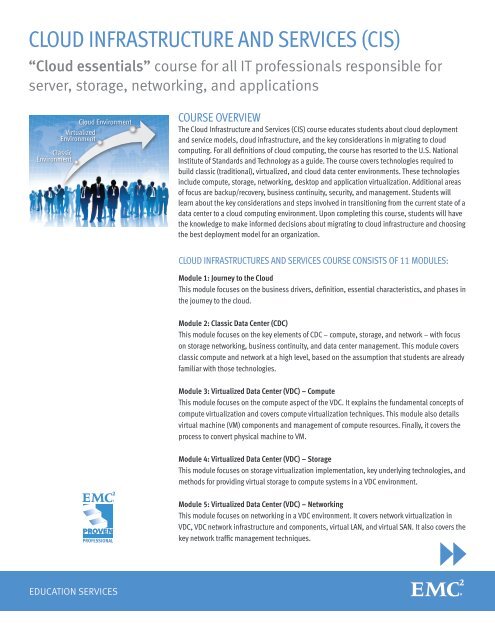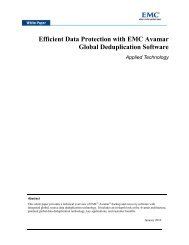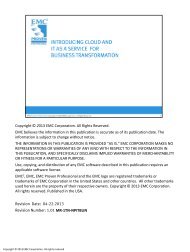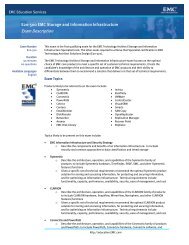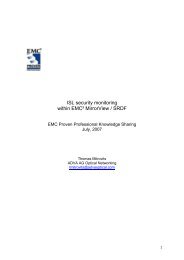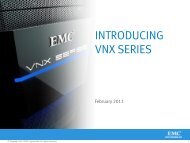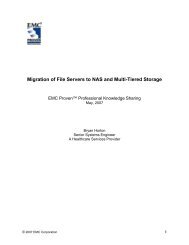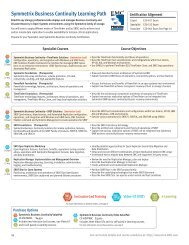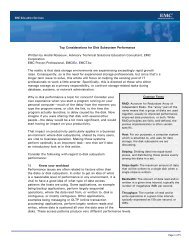CLOUD INFRASTRUCTURE AND SERVICES (CIS)
CLOUD INFRASTRUCTURE AND SERVICES (CIS)
CLOUD INFRASTRUCTURE AND SERVICES (CIS)
Create successful ePaper yourself
Turn your PDF publications into a flip-book with our unique Google optimized e-Paper software.
<strong>CLOUD</strong> <strong>INFRASTRUCTURE</strong> <strong>AND</strong> <strong>SERVICES</strong> (<strong>CIS</strong>)<br />
“Cloud essentials” course for all IT professionals responsible for<br />
server, storage, networking, and applications<br />
Classic<br />
Environment<br />
Cloud Environment<br />
Virtualized<br />
Environment<br />
COURSE OVERVIEW<br />
The Cloud Infrastructure and Services (<strong>CIS</strong>) course educates students about cloud deployment<br />
and service models, cloud infrastructure, and the key considerations in migrating to cloud<br />
computing. For all definitions of cloud computing, the course has resorted to the U.S. National<br />
Institute of Standards and Technology as a guide. The course covers technologies required to<br />
build classic (traditional), virtualized, and cloud data center environments. These technologies<br />
include compute, storage, networking, desktop and application virtualization. Additional areas<br />
of focus are backup/recovery, business continuity, security, and management. Students will<br />
learn about the key considerations and steps involved in transitioning from the current state of a<br />
data center to a cloud computing environment. Upon completing this course, students will have<br />
the knowledge to make informed decisions about migrating to cloud infrastructure and choosing<br />
the best deployment model for an organization.<br />
<strong>CLOUD</strong> <strong>INFRASTRUCTURE</strong>S <strong>AND</strong> <strong>SERVICES</strong> COURSE CONSISTS OF 11 MODULES:<br />
Module 1: Journey to the Cloud<br />
This module focuses on the business drivers, definition, essential characteristics, and phases in<br />
the journey to the cloud.<br />
Module 2: Classic Data Center (CDC)<br />
This module focuses on the key elements of CDC – compute, storage, and network – with focus<br />
on storage networking, business continuity, and data center management. This module covers<br />
classic compute and network at a high level, based on the assumption that students are already<br />
familiar with those technologies.<br />
Module 3: Virtualized Data Center (VDC) – Compute<br />
This module focuses on the compute aspect of the VDC. It explains the fundamental concepts of<br />
compute virtualization and covers compute virtualization techniques. This module also details<br />
virtual machine (VM) components and management of compute resources. Finally, it covers the<br />
process to convert physical machine to VM.<br />
Module 4: Virtualized Data Center (VDC) – Storage<br />
This module focuses on storage virtualization implementation, key underlying technologies, and<br />
methods for providing virtual storage to compute systems in a VDC environment.<br />
Module 5: Virtualized Data Center (VDC) – Networking<br />
This module focuses on networking in a VDC environment. It covers network virtualization in<br />
VDC, VDC network infrastructure and components, virtual LAN, and virtual SAN. It also covers the<br />
key network traffic management techniques.<br />
EDUCATION <strong>SERVICES</strong>
Module 6: Virtualized Data Center (VDC) – Desktop and Application<br />
This module focuses on the various aspects of desktop and application virtualization technologies.<br />
Module 7: Business Continuity in VDC<br />
This module focuses on the concepts and techniques employed for ensuring business continuity<br />
in a Virtualized Data Center (VDC) environment. It discusses the mechanisms to protect single<br />
point of failure in a VDC. Next, it covers the various technology options for backup, replication,<br />
and migration of Virtual Machines (VM) and their data in a VDC environment. Finally, it discusses<br />
the various options for recovering from total site failure due to a disaster.<br />
Module 8: Cloud Computing Primer<br />
This module focuses on the essential characteristics of cloud computing, the various cloud<br />
services and deployment models, and the economics of cloud.<br />
Module 9: Cloud Infrastructure and Management<br />
This module focuses on the cloud infrastructure components and cloud service creation processes.<br />
It also includes the cloud service management processes that ensure that the delivery of cloud<br />
services is aligned with business objectives and expectations of cloud service consumers.<br />
Module 10: Cloud Security<br />
This module focuses on security concerns and counter measures in a VDC and cloud<br />
environment. It discusses key security concerns and threats. It covers various infrastructure<br />
security mechanisms in VDC and cloud environments, including access control, identity<br />
management, governance, and more. Additionally, the module lists cloud security best<br />
practices.<br />
Module 11: Cloud Migration Considerations<br />
This module focuses on considerations for migration to the cloud. It details ‘cloud models’<br />
suitable for different categories of users. Further, it covers considerations for choosing candidate<br />
application and various other considerations for migration to cloud. It also covers various<br />
phases of cloud adoption.<br />
Student profile for success<br />
Students who have completed courses on the following topics will have an added advantage in<br />
successfully completing the <strong>CIS</strong> course:<br />
1. Computer systems and architectures<br />
2. Networking technologies<br />
3. Operating system<br />
4. Information storage and management<br />
EDUCATION <strong>SERVICES</strong>


